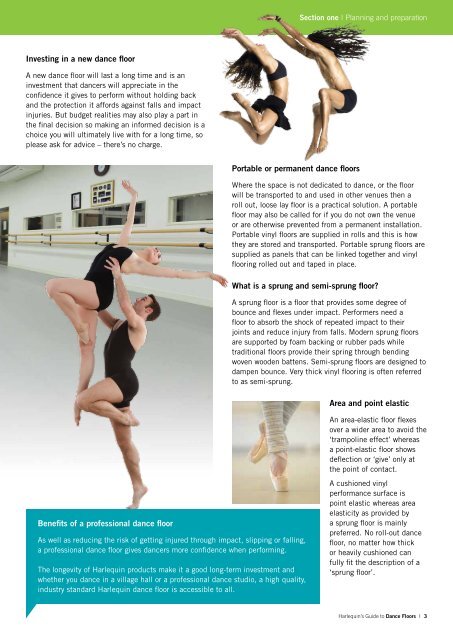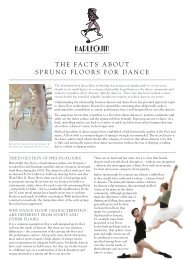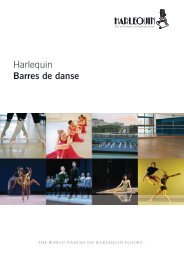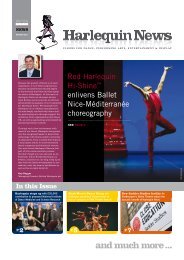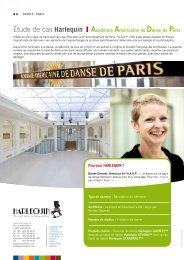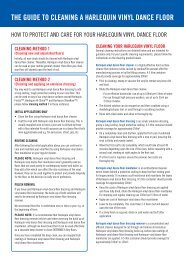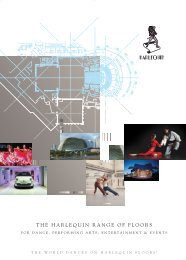Harlequin's Guide to Dance Floors - Harlequin Floors
Harlequin's Guide to Dance Floors - Harlequin Floors
Harlequin's Guide to Dance Floors - Harlequin Floors
You also want an ePaper? Increase the reach of your titles
YUMPU automatically turns print PDFs into web optimized ePapers that Google loves.
Section one I Planning and preparation<br />
Investing in a new dance floor<br />
A new dance floor will last a long time and is an<br />
investment that dancers will appreciate in the<br />
confidence it gives <strong>to</strong> perform without holding back<br />
and the protection it affords against falls and impact<br />
injuries. But budget realities may also play a part in<br />
the final decision so making an informed decision is a<br />
choice you will ultimately live with for a long time, so<br />
please ask for advice – there’s no charge.<br />
Portable or permanent dance floors<br />
Where the space is not dedicated <strong>to</strong> dance, or the floor<br />
will be transported <strong>to</strong> and used in other venues then a<br />
roll out, loose lay floor is a practical solution. A portable<br />
floor may also be called for if you do not own the venue<br />
or are otherwise prevented from a permanent installation.<br />
Portable vinyl floors are supplied in rolls and this is how<br />
they are s<strong>to</strong>red and transported. Portable sprung floors are<br />
supplied as panels that can be linked <strong>to</strong>gether and vinyl<br />
flooring rolled out and taped in place.<br />
What is a sprung and semi-sprung floor?<br />
A sprung floor is a floor that provides some degree of<br />
bounce and flexes under impact. Performers need a<br />
floor <strong>to</strong> absorb the shock of repeated impact <strong>to</strong> their<br />
joints and reduce injury from falls. Modern sprung floors<br />
are supported by foam backing or rubber pads while<br />
traditional floors provide their spring through bending<br />
woven wooden battens. Semi-sprung floors are designed <strong>to</strong><br />
dampen bounce. Very thick vinyl flooring is often referred<br />
<strong>to</strong> as semi-sprung.<br />
Area and point elastic<br />
An area-elastic floor flexes<br />
over a wider area <strong>to</strong> avoid the<br />
‘trampoline effect’ whereas<br />
a point-elastic floor shows<br />
deflection or ‘give’ only at<br />
the point of contact.<br />
Benefits of a professional dance floor<br />
As well as reducing the risk of getting injured through impact, slipping or falling,<br />
a professional dance floor gives dancers more confidence when performing.<br />
The longevity of <strong>Harlequin</strong> products make it a good long-term investment and<br />
whether you dance in a village hall or a professional dance studio, a high quality,<br />
industry standard <strong>Harlequin</strong> dance floor is accessible <strong>to</strong> all.<br />
A cushioned vinyl<br />
performance surface is<br />
point elastic whereas area<br />
elasticity as provided by<br />
a sprung floor is mainly<br />
preferred. No roll-out dance<br />
floor, no matter how thick<br />
or heavily cushioned can<br />
fully fit the description of a<br />
‘sprung floor’.<br />
<strong>Harlequin</strong>’s <strong>Guide</strong> <strong>to</strong> <strong>Dance</strong> <strong>Floors</strong> I 3


